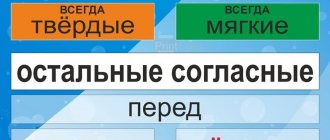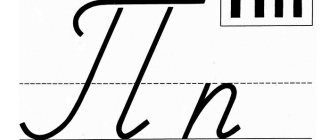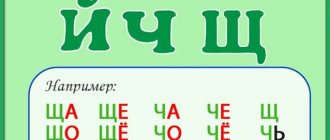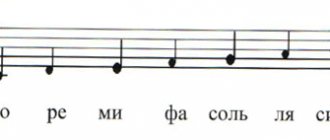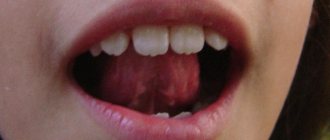What are voiced consonants?
Our speech consists of segments that are complete in meaning and intonation, which are called sentences. Each sentence is made up of individual words, and words in turn are made up of sounds. Sound is the minimal unit of speech, like words and sentences.
Sounds vary in quality. Those sounds in the formation of which only the voice participates are called vowels . These are the sounds [a], [o], [u], [e], [i], [s], which are pronounced in an open voice. The rest of our speech sounds are noisy . But they make different noises. Those sounds that are pronounced with the participation of voice and noise are voiced. When they form, air passes through the vocal cords as you exhale and causes them to tremble and vibrate. This vibration of the vocal cords can be felt by placing your hands on your throat. If you plug your ears, then when pronouncing voiced consonants, ringing in the ears occurs. When pronouncing voiceless consonants, which consist only of noise, such vibration of the vocal cords and ringing in the ears is not felt. Definition Voiced consonants are noisy speech sounds, in the formation of which noise predominates over the voice.
In the phonetics of the Russian language, there are 20 voiced sounds, which in written speech are designated by 11 letters:
- the letter “b” is the sounds [b] or [b']
- “in” - [in] or [in']
- "g" - [g] or [g']
- “d” - [d] or [d']
- “zh” - [zh]
- “z” - [z] or [z']
- "th" - [th']
- "l" - [l] or [l']
- “m” - [m] or [m']
- “n” - [n] or [n']
- “p” - [p] or [p'].
Most letters representing voiced consonants are found at the beginning of the alphabet. As you can see, many voiced consonants form pairs based on softness/hardness.
What sounds are called voiced
When pronouncing all consonants, air passes through barriers in the speech apparatus, which is why their production requires more effort than for vowel sounds. This process also affects the amount of noise, so consonants are divided into two categories: voiced and voiceless. When pronouncing dull sounds, you will produce more noise than voice; voiced ones sound bright and distinct.
Setting the sound D
In order for a child’s speech to be clear and correct, and for those around him to understand, all sounds must be pronounced clearly. This applies to all the letters of the alphabet, to all the sounds that they form.
Some sounds are pronounced immediately without flaw, while others do not want to be absorbed. Such sounds must first be delivered, then automated and reinforced in speech.
Sound production is carried out after the articulation of sound has been worked out and the speech organs have been prepared.
The following methods are used for staging:
1. Imitation. A child next to an adult in front of a mirror. An adult shows how to pronounce a sound. The child repeats. First, they train with vowel sounds (da-do-du-dy) for hard D and (de-di-du-dya) for soft D.
2. Mechanical method. Pronounced "B" - tongue between lips. The speech therapist, using a spatula, presses the tip of the tongue and places it behind the upper teeth.
These methods are effective for a child to practice with loved ones so that the child feels calm.
Soft and hard voiced consonants
All voiced consonants differ in terms of softness/hardness, except for the always hard voiced consonant [zh] and the always soft (palatal) sound [th'].
The pronunciation of soft and hard consonants differs in the position of the tongue. When forming a soft consonant, the middle back of the tongue arches towards the speaker's palate.
The softness and hardness of voiced consonants depends on their phonetic position in the word. If after them there are vowels [a], [o], [u], [e], [s], then the consonants are pronounced firmly.
- bun [bu lka]
- gate [gate]
- hum [g u l]
- gift [d a r]
- z a r i [za r'a].
If after the consonants the letters “e”, “e”, “i”, “yu”, “ya”, “b” are written, then when pronouncing words, the voiced consonants sound soft:
- tag [b' and r k a]
- dove [g o l u b ']
- evening [v' e h' and r]
- hero [g' and r o y']
- woodpecker [d' a t' and l]
- winter [z' and m a]
The listed voiced consonants have paired voiceless consonants. Voiceless consonants form a pair with similar voiced consonants. Only in their education there is almost no voice, and noise predominates.
What vowel letters represent 2 sounds?
Everyone knows that consonants can be hard and soft. If after consonant letters there are vowels E, Ë, Yu, I, then they indicate the softness of the previous one.
For example: children, ice, trousers, woodpecker.
If you pronounce these words slowly, the sounds E, O, U, A
An equally interesting example is when the letters E, S, Yu, I come first.
Let's look at examples:
- raccoon - the letter E makes two sounds [YE] ;
- Zhik - begins with Ë , giving 2 sounds [YO] ;
- yurt - Yu gives 2 sounds [YU] ;
- Yama - also two sounds [YA] .
It can be noted that in these words the first thing heard is Y (yot) , therefore such vowels are usually called iotized .
If the letters E, Ë, Yu, I come after vowels, they also make two sounds. Here is a striking example of such a phonetic position:
- hygiene - hygiene[YE]na;
- sing - by [YO]t;
- cabin - cabin [YU]ta;
- hare - for[YA]ts.
There is a third option, when vowels represent two sounds. Please note that the letters E, Ë, Yu, I, standing after the disjunctive signs b and b, make two sounds.
You can verify this by looking at examples:
- pours - l[YO]t;
- razd - raz[YE]zd;
- serious - serious;
- cringe - cringe;
- drink - p[YU]t;
- adjutant - adjutant;
- weeds - bur [YA]n;
- announcement - announcement [YA] announcement.
Paired voiced
There are 20 voiced sounds in the Russian language, and they are designated by 11 letters. In turn, they are divided into paired and unpaired. Paired voiced ones are:
- [b] - boot [bat'inak], beet [bur'ak], Pinocchio [burat'ina];
- [b'] - to love [l'ub'it'], thrifty [b'ir'izhl'ivy'], advertisement [ab'y'ivl'en'iy'e];
- [v] - driver [vad'it'il'], lie [vrat'], beer [p'iva];
- [v'] - wreath [v'inok], see [uv'id'it'], deja vu [d'izhav'u];
- [g] - race [race], deafening [audushyt'il'nyy'], warm [sagr'et'];
- [g'] - coat of arms [g'erp], garland [g'irl'an'da], hero [g'erai'];
- [d] - long [dl'in:y'], wait [padazdat'], soul [soul];
- [d'] - duchess [d'ushes], village [d'ir'evn'a], lonely [ad'inok'iy'];
- [z] - gold [zolata], St. John's wort [z'irobay'], belly [pusa];
- [z'] - strawberry [z'iml'in'ika], earth [oz'im'], winter [z'ima];
- [zh] - leather [leather'], acorn [zholut'], rozhon [razhon].
These consonants are called paired because there are dull sounds that sound similar to them - only with less voice and more noise. These are the sounds [p], [p'], [f], [f'], [k], [k'], [t], [t'], [s], [s'], [sh] . Try to pronounce the sound from the previous list and this list alternately and you will immediately understand what we are talking about.
Examples of phonetic parsing of words
To consolidate the material we have covered, let’s turn to the sound-letter analysis of words:
- bright [bright] – 5 points, 6 stars;
- hedgehog [yozhik] – 4 points, 5 stars;
- cabin boy [yunga] – 4 points, 5 stars;
- land [land] – 5 points, 5 stars;
- sing [sing] – 4 points, 5 stars;
- bindweed [v´junok] – 6 points, 6 stars;
- trees [d´er´eev´ya] – 7 b., 8 stars;
- entrance [entry] – 5 points, 5 stars.
Let us once again be convinced that the letters E, Ë, Yu, I can give softness to the previous consonant or two sounds. For ease of perception, we divide the words into two columns:
- stump - warms;
- mint – Yacht;
- screwdriver – Ërsh;
- plus – Skirt.
Having learned the vowel position rule in second grade, you can write correctly in high school. Regular reading of books aloud, rewriting and memorizing texts, and using a spelling dictionary prevents errors.
Unpaired voiced consonants
In the Russian language, in addition to the paired consonants considered, there are unpaired voiced consonants, which are pronounced with more voice than noise. They are called the term "sonorous", which goes back to the Greek word sonorus, which means "sonorous". As is clear from their name, sonorant consonants, by their nature, do not have a voiced/voiced pair. This group of consonants consists of 9 sounds, designated in written speech by letters:
- the letter "th" is the sound [th']
- the letter “l” is the sounds [l] or [l']
- the letter "m" is [m] or [m']
- the letter "n" is [n] or [n']
- the letter "p" is [p] or [p'].
Sonorant sounds, except for [th'], form pairs with each other based on hardness/softness.
Let's observe:
- weasel [l] - lyre [l']
- milk [m] - broom [m']
- mink [n] - seal [n']
- lynx [r] - duckweed [r'].
They do not change their sound quality and do not depend on the phonetic position in the word. The remaining voiced consonants are influenced by voiceless consonants. Their quality varies depending on their location in the word. Let us consider these phonetic processes in more detail.
Unpaired voiced
Unpaired voiced consonants do not have dull-sounding analogues. They are also called sonorous because they sound more expressive:
- [th'] - yogurt [y'ogurt], terrible [terrible'], coyote [koy'at];
- [l] - sawdust [ap'ilk'i], basket [lukushka], lily of the valley [lily of the valley];
- [l'] - elegant [el'igan'tna], lazy [l'in't'ay'], drake [s'el'iz'in'];
- [m] - silently [silent'a], smart [smart'], unique [un'ikum];
- [m'] - dream [m'ich'tat'], minister [m'in'istr], treason [iz'ena];
- [n] - knockout [knockout], necessary [necessary'], flooring [nast'il];
- [n'] - nowhere [n'egd'e], shampoo [shampoo'], fire [agon'];
- [r] - romance [raman], joyful [radasny'], defeat [parazhen'ii'e];
- [r'] - glass [r'umka], river boat [r'ich'nik], margarine [margar'in].
You can easily remember all the voiced consonants using the phrase “The lion and the toad have many friends.”
Consonants and letters
What sounds are called consonants? What does a consonant sound consist of? What are the different consonant sounds? How many consonant letters and consonant sounds are there in the Russian alphabet? Which consonants are always hard and which are always soft? What letters indicate the softness of a consonant?
Sounds in the pronunciation of which the air encounters an obstacle in the mouth are called consonant sounds . A consonant sound consists of noise and voice or only noise.
Consonant sounds are divided into voiced and voiceless . Voiced ones consist of noise and voice, while deaf ones consist only of noise.
The following sounds are made up of noise and voice: [b], [v], [d], [d], [z], [z], [y], [l], [m], [n], [r] . These consonant sounds are called voiced.
The sounds only consist of noise: [k], [p], [s], [t], [f], [x], [ts], [ch], [sh], [sch]. These are voiceless consonants.
Many consonant sounds form pairs based on voicedness and deafness : [b]—[p], [v]—[f], [g]—[k], [d]—[t], [z]—[s], [g]—[w].
To memorize voiced consonants, you can learn the phrase: “ The Lion and the Toad HAVE MANY FRIENDS .” See all phrases for memorizing voiced and voiceless consonants.
Voiceless consonants are easy to remember from the phrase: “ Styopka, Do you want ShcheTs?” - Ugh! "
Consonant sounds are indicated by letters:
B , V , G , D , F , Z , J , K , L , M , N , P , R , S , T , F , X , C , H , W , SCH .
21 consonants in the Russian language .
Consonant sounds are also hard and soft.
Hard and soft sounds differ in the position of the tongue when pronounced. When pronouncing soft consonants, the middle back of the tongue is raised towards the hard palate.
Most consonant sounds form pairs based on hardness and softness:
| Solid | [b] | [V] | [G] | [d] | [h] | [To] | [l] | [m] | [n] | [P] | [R] | [With] | [T] | [f] | [X] |
| Soft | [b'] | [V'] | [G'] | [d'] | [z'] | [To'] | [l'] | [m'] | [n'] | [P'] | [R'] | [With'] | [T'] | [f'] | [X'] |
The following hard and soft consonant sounds do not form hard-softness pairs:
| Solid | [and] | [w] | [ts] |
| Soft | [h❜] | [sch❜] | [th❜] |
Table “Consonant sounds: paired and unpaired, voiced and voiceless, hard and soft” (grades 1-4)
Note: in elementary school, hard consonant sounds are indicated in blue, soft consonant sounds in green, and vowel sounds in red.
The hardness of consonant sounds is indicated in writing by the vowels A , O , U , Y , E.
The softness of a consonant sound is indicated in writing by the vowels E, E, I, Yu, I , as well as the letter b (soft sign).
Compare: nose [nose] - carried [n❜os], corner [angle] - coal [ugal❜].
Unpaired voiced sounds [й❜], [l], [l❜], [m], [m❜] [n], [n❜] [р], [р❜] are called sonorant , which translated from Latin means "resonant".
The sounds [zh], [sh], [ch❜], [sch❜] are called hissing . They got this name because their pronunciation is similar to hissing.
The sounds [zh], [sh] are unpaired hard hissing sounds. The sounds [ch❜] and [ш❜] are unpaired soft hissing sounds.
The sounds [c], [s❜], [z], [z❜], [ts] are called whistling .
A consonant sound is neither stressed nor unstressed.
In the Russian language, there are more consonant sounds (36) than consonant letters (21), since one letter can denote paired hard and soft sounds: for example, the letter L (el) denotes the sounds [l] and [l❜].
Attention! A consonant sound can form a syllable only with a vowel sound .
►
Stunning of voiced consonants
Voiced consonants, if they are at the end of a word, are in a weak phonetic position and are subject to deafening. When pronounced, they are replaced by their paired voiceless consonants:
- box [box]
- norov [noraf]
- threshold [steam]
- parade [parad]
- watchman [stohrash]
- frost [frost].
If a voiced consonant is located before a voiceless one, then similarly this is a weak phonetic position for it. The voiced consonant is affected by the voiceless consonant and becomes similar to it, that is, it changes its quality and sounds muffled. Assimilation of a voiced consonant occurs (Latin assimilatio - “likening”, “comparison”) on the basis of deafness/voice.
Let's observe:
- shelling [a p s t r' e l]
- pampering [bal a f s t v o]
- factory [za v a t s k o y']
- pointer
- tramp [b r a d ' a sh k a].
Consonant sounds do not form a phonetic syllable on their own, but only when paired with vowel sounds.
Positions in words of vowels giving 2 sounds (table)
The positions of vowel letters producing two sounds require certain conditions to be met. We reviewed them above.
To make it easier to remember the rule, you can use the notation table.
| Yotated vowels E, Ë, Yu, I give 2 sounds if they stand: | ||
| At the beginning of the word | After a vowel | After the separating sign b or b |
| Anchor | snake | KurErobEd |
Tags
and voiced consonants to distinguish voiced consonants to distinguish voiced from deaf and from deaf. and voiceless consonants and voiceless in the English language in the Russian language in the Russian language are divided in the Russian language lived the English language in the Russian language in the Russian language words
softclasspartsindicateexamplesphoneticsquestionsrulesidentifypronouncetextbookreplyvoicecommentsrememberwillmaincalleducationnopronouncereadingalwayspronouncewhoevernameearssiteworthsentencesjustworksread
Consonants
Consonant sounds constitute a larger group of the phonetic structure of the Russian language. There are 36 of them. Compared to vowels, consonant sounds have a different quality. They are pronounced muffledly and are formed with little participation of the voice, which is necessarily accompanied by noise. Noise occurs if, when pronouncing a consonant sound, a stream of air encounters an obstacle in the form of a raised tongue, rubs against the walls of the cheeks, as a result of closing and opening the lips, etc. Definition Consonant sounds are sounds in the formation of which noise is involved.
According to the degree of participation of voice and noise, consonant sounds are divided into sonorant and noisy .
Sonorant sounds are sounds in which noise is minimal and the voice predominates.
Let's list the sonorant sounds: [l], [l'], [m], [m'], [n], [n'], [r], [r'].


